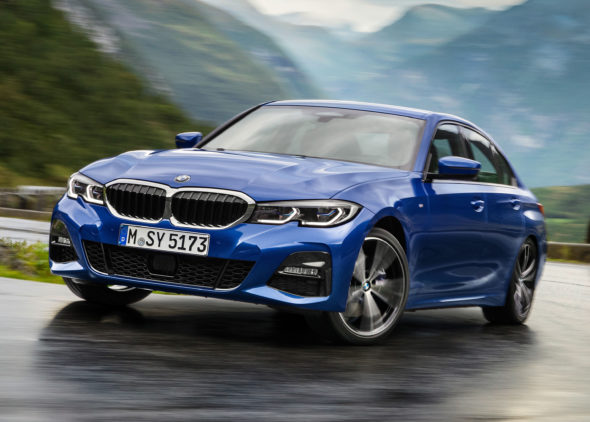 Few cars strike the balance between aspiration and accessibility as expertly as the BMW 3 Series. Since the original appeared in 1975 the 3 Series has been the car of choice for those who want an upmarket image, superb build quality and sublime handling. In total more than 15 million have been sold – which makes the arrival of an all-new version somewhat important.
Few cars strike the balance between aspiration and accessibility as expertly as the BMW 3 Series. Since the original appeared in 1975 the 3 Series has been the car of choice for those who want an upmarket image, superb build quality and sublime handling. In total more than 15 million have been sold – which makes the arrival of an all-new version somewhat important.
PRECISION AND POETRY
Compared with the aesthetic changes that occurred between each of its predecessors, this latest 3 Series, codename G30, at first appears to have graduated from a school of design that favours evolution rather than revolution. However, look a little closer and you’ll realise that the familiarity is not wholly connected with the previous F30-generation of 3 Series, but also the current 5 Series.
For a start there’s the much wider kidney grilles, echoing the current automotive market trend for cars with ever more prominent nostrils. It’s not just the grille either; indeed, the whole car is larger than before, having grown 85mm in length, 16mm in width and a single millimetre in height (although it is still around 50kg lighter than before thanks to more extensive use of aluminium).
 This larger body has in turn allowed BMW to stretch the wheelbase and track to improve ride and handling, which bodes well given the outgoing 3 Series was already the class leader in this regard.
This larger body has in turn allowed BMW to stretch the wheelbase and track to improve ride and handling, which bodes well given the outgoing 3 Series was already the class leader in this regard.
It’s arguably at the rear, however, where the new 3 Series is most striking, with smoked light lenses and a much more coupe-like (and dare we even say Audi-esque?) appearance than before. It’s all part of BMW’s new ‘Precision and Poetry’ design language.
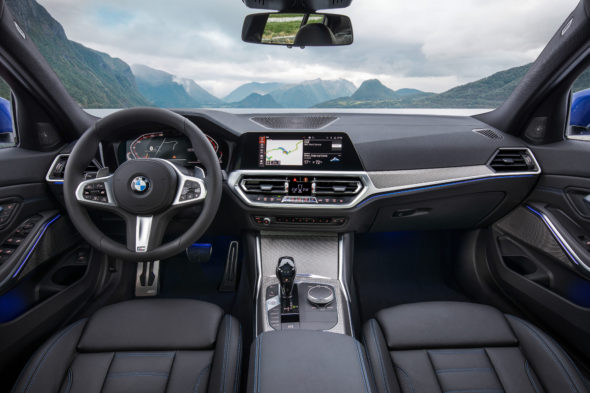 ON THE INSIDE
ON THE INSIDE
The interior is completely new and majors on angles, although traditional 3 Series touches are still evident, such as the central panel and touchscreen infotainment display (8.8 inches as standard, upgradable to 10.25 inches) being oriented towards the driver. There are, however, fewer buttons than before, and what buttons do remain have been grouped together either by the central air vents or near the gear lever.
All models now come with a sports steering wheel and ambient lighting (with 11 selectable colours), and overall quality is said to have taken a step forward. As standard the speedometer and rev counter are of the traditional analogue variety, flanking a 5.7-inch screen for the trip computer, but buyers can also upgrade to a full 12.3-inch digital dial display.
SPECIFICATION AND EQUIPMENT
The trim levels will mirror what’s currently available, but with more equipment coming as standard. The entry-level SE, for example, now includes 17-inch alloy wheels, LED headlights, a reversing camera, three-zone air-conditioning and 40:20:40 split folding rear seats.
Next up is the Sport version with its 18-inch alloys, upgraded styling with more gloss black detailing, and heated leather sports seats.
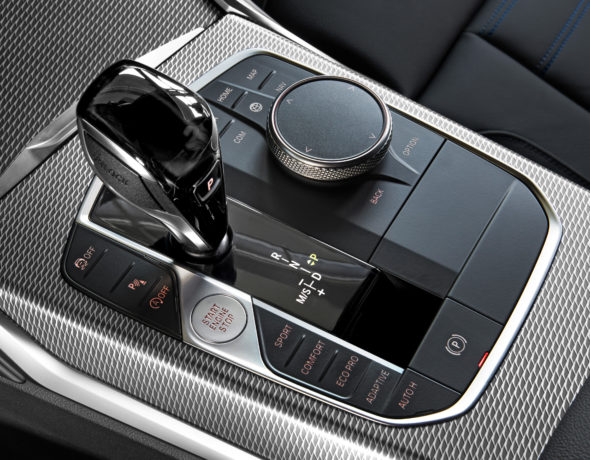 The top M Sport spec models sit on 10mm lowered sports suspension and have even more aggressive body styling with larger air intakes, while inside there’s more aluminium trim and the full digital instrument cluster.
The top M Sport spec models sit on 10mm lowered sports suspension and have even more aggressive body styling with larger air intakes, while inside there’s more aluminium trim and the full digital instrument cluster.
The list of optional extras has been simplified, with much of it bundled into packages. For example, the M Sport Plus pack features adaptive dampers, 19-inch wheels and, on the 330i model, an electronic limited-slip differential. A Technology package meanwhile adds a head up display, wireless charging and an upgraded sound system, while the Comfort pack includes a heated steering wheel, keyless access and an automatic tailgate.
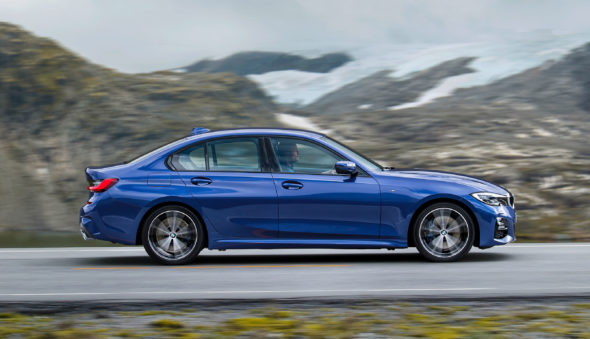 TWO TECHNOLOGICAL HIGHLIGHTS
TWO TECHNOLOGICAL HIGHLIGHTS
As you’d expect, there’s a wide range of technology on offer, including numerous safety and driver assistance systems. The highlight though must be the Reversing Assistant, which can guide the car backwards up to 50 metres along the same path you’ve just driven in order to help navigate in confined spaces.
As is increasingly the way, there’s also a new personal assistant system featuring natural speech recognition. Simply say ‘Hey BMW’ and then either give your command (for example ‘I’m cold’ in order to turn up the heating), or just initiate a conversion. BMW calls it ‘the ideal co-driver’, but we still can’t help thinking there’s something a bit spooky about having a chat with your car.
ENGINES AND PRICES
The core 320d model will remain, its 2.0-litre, four-cylinder diesel engine producing 187bhp, a 0-62mph time of 7.1 seconds, fuel economy of 64.2mpg and CO2 emissions of 115g/km (when equipped with the six-speed manual gearbox). This engine is available with rear-wheel drive or xDrive four-wheel drive, as well as with BMW’s eight-speed automatic gearbox.
Those who prefer petrol can opt for the 330i, which uses a 2.0-litre, four-cylinder turbocharged engine that produces figures of 255bhp, 5.8 seconds from 0-62mph, 48.7mpg and 132g/km of CO2.
Also on the cards are a 330e plug-in hybrid, a six-cylinder 330d, M40i and M40d performance models and, eventually, an all-new M3.
The new 3 Series goes on sale in March 2019 with prices starting from £33,610 for a 320d in SE specification, rising to £37,660 for a 330i.
MODEL HISTORY
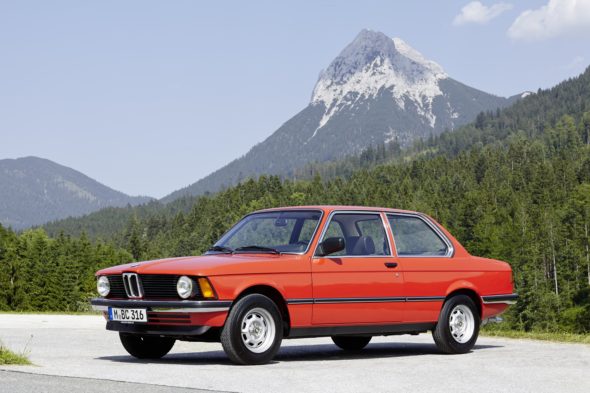 BMW 3 Series Mk1
BMW 3 Series Mk1
Codenamed E21, the original 3 Series kickstarted a range of cars that is now moving into its seventh generation. It was originally available with two doors and four-cylinder engines, but a six-cylinder model followed.
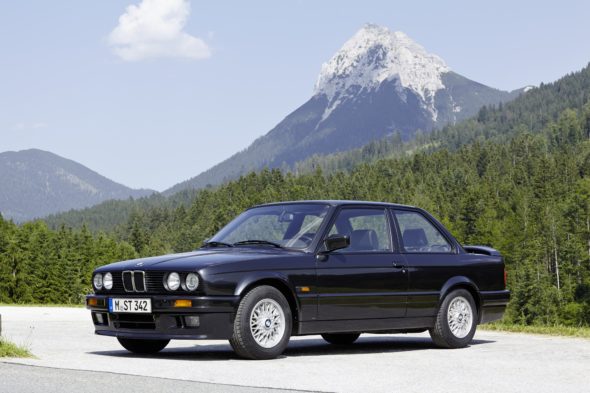 BMW 3 Series Mk2
BMW 3 Series Mk2
The E30-generation of 3 Series was launched in 1982 and was available as a saloon and a Touring estate, marking a first for BMW’s most compact offering. Significantly, it was the car on which the first M3 was based, complete with a hard-charging four-cylinder engine and sublime handling.
Search for a second-generation BMW 3 Series on CarGurus
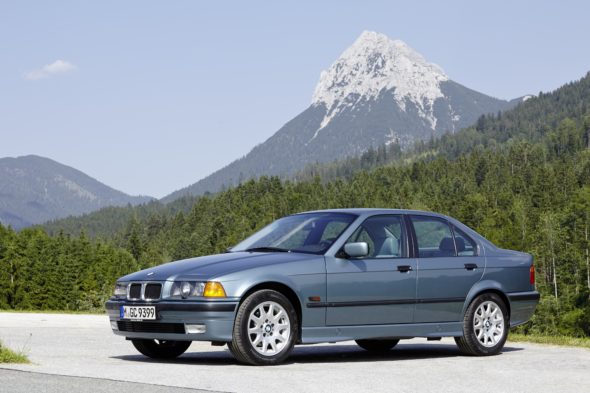 BMW 3 Series Mk3
BMW 3 Series Mk3
By 1990 BMW had moved on to the third-generation of 3 Series, known as the E36. This was a larger and even more upmarket car than before, with a wide range of engines and body styles. Again there was an M3 version, this time powered by a six-cylinder engine.
Search for a third-generation BMW 3 Series on CarGurus
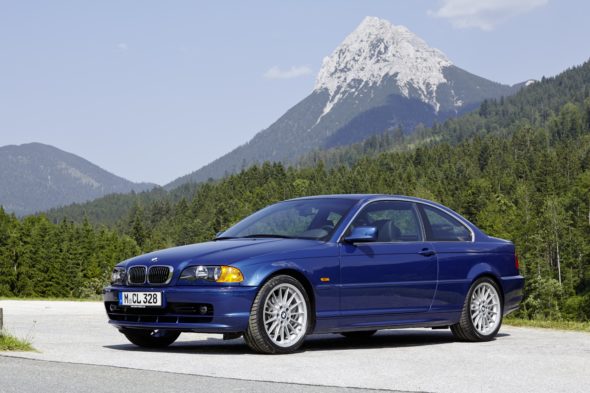 BMW 3 Series Mk4
BMW 3 Series Mk4
Good examples of the fourth-generation ‘E46’ BMW 3 Series are fast moving into modern classic territory thanks to their combination of superb build quality, excellent reliability and class-leading dynamics. The six-cylinder M3 version is a landmark performance car, with the best examples now rising in value.
Search for a fourth-generation BMW 3 Series on CarGurus
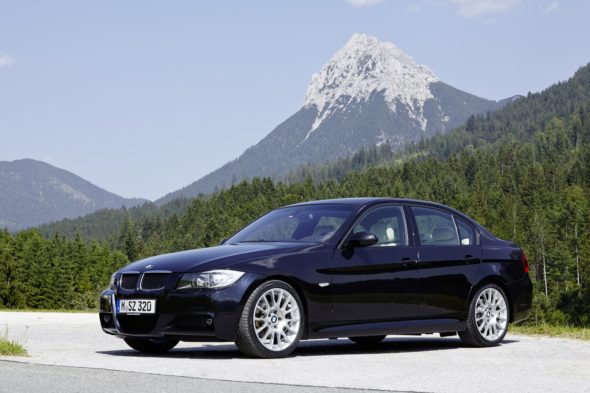 BMW 3 Series Mk5
BMW 3 Series Mk5
Known as the E90, the fifth generation 3 Series moved the game on once more, particularly in terms of performance and fuel economy. In hugely popular 320d guise it is arguably all the car you could ever need, being quick, quiet and running for 500 miles or more between refills. The M3 model wasn’t quite as efficient, but its high revving V8 engine is a gem.
Search for a fifth-generation BMW 3 Series on CarGurus
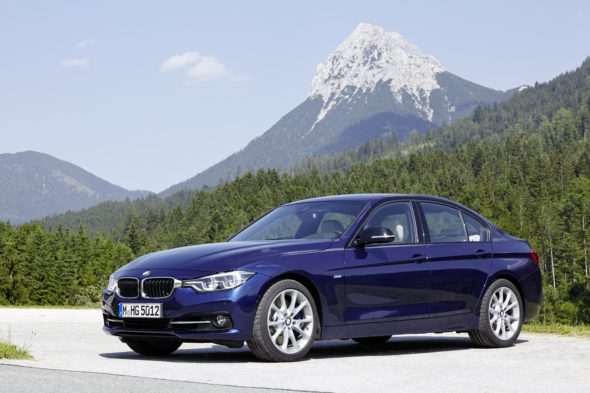 BMW 3 Series Mk6
BMW 3 Series Mk6
This is the car the latest G30 model needs to be beat. Codenamed F30, the outgoing 3 Series is widely regarded as the best compact executive saloon in the world, combining technology, space and a rewarding driving experience in almost perfect harmony.
Search for a sixth-generation BMW 3 Series on CarGurus
In the market for a used car? CarGurus makes it easy to find great deals from top-rated dealers. CarGurus compares price, detailed vehicle data and dealer reviews to give each used car a deal rating from great to overpriced, and sorts the best deals first. Find out more and begin your used car search at CarGurus
The content above is for informational purposes only and should be independently verified. Please see our Terms of Use for more details.
This is the All-New BMW 3 Series posted first on http://www.cargurus.com/blog/
No comments:
Post a Comment